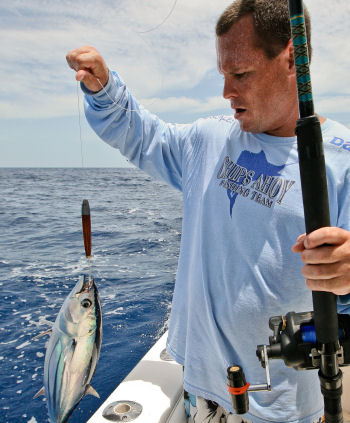Plug A Tuna
Known for their proficiency in enticing tuna, cedar plugs are practically indestructible and capable of catching just about any pelagic predator that swims. While you may have your sights set on yellowfin or blackfin, don’t rule out a battle with a dolphin, wahoo or billfish. At first glance you may be under the impression that the streamlined shape of a cedar plug offers relatively little action, but this can’t be any further from the truth. When trolled at speeds from 6 to 9-knots, the darting and dancing action is deadly effective. And while their irresistible action is what draws in inquisitive predators, their small stature makes them easy targets for unrelenting pelagics. While simplistic they are there are a few aspects in regards to rigging and running that will greatly enhance your catch ratio, as these classics are prone to pulling hooks.
 While no doubt a quality producer pulled across the entire eastern seaboard and beyond, the simple cedar plug is widely considered the ugly duckling in a spread of pricey polyurethane producers. But if you remember how the classic fairy tale ends, the disliked duckling comes out on top. |
Courtesy of – Florida Sport Fishing magazine
Summertime in The Bahamas means one thing to both resident and visiting anglers - hordes of spooky yellowfin tuna. Scan the docks of nearly every marina throughout the entire Bahamian archipelago and you won’t get far before you spot a few cedars. While traditional cedar plugs are crafted of cedar wood and adorned with a lead head, modern variations utilize aluminum or plastic and are available in every color combination imaginable. When it comes to color selection, the natural cedar finish is believed to allow anglers to dip these cigar-shaped fish-catchers in menhaden oil to further promote their “eat-me” attributes. While this practice isn’t common, color is, without a doubt, a major factor.
Most professionals prefer the standard 6” cedar plug with its natural finish, they are also available in 4” and 8” variations with numerous painted color schemes. Similar to varying sizes, manufacturers are also experimenting with weight distribution in an effort to increase the lures’ overall appeal.
Crimping Details
When it comes to rigging, not many blue water offerings compare with a cedar plug’s terminal tackle simplicity. Most successful tuna wranglers rig with an 8/0 to 10/0 long shank needle-eye hook, accompanied with 8-feet of 150lb. monofilament leader. Needle-eye hooks are essential, as hooks with standard eyes won’t fit into the base of the lure. Start by crimping a loop before sliding the opposite end of the leader through the head of the lure. Next, crimp your needle-eye hook into place and position the hook shank into the body of the lure.
Plugs Away!
While successful on their own, a daisy chain of cedars can create incredible commotion. To rig a daisy chain of in-line cedar plugs start with a 8-foot section of 150lb. monofilament. You’ll want to stagger the plugs approximately 15-inches apart by placing a barrel swivel behind the plugs (all but the rear plug which is equipped with a hook). When attaching the final plug, increase the distance to 24-inches. The longer gap will single out the hooked lure and create the illusion of a weak baitfish.
It’s a fish-eat-fish world, and your trailing baitfish will likely get the most attention. A cedar tree is yet another variation and features cedar plugs that are rigged with short lengths of mono branching off the main leader.
Whether you’re fishing a single cedar or daisy chain, you’ll want to routinely check for nicks and abrasion in the leader.
Shotgun Plug
When it comes to location in your spread, there’s no better placement for a single cedar than the shotgun position way, way back. When placing a cedar plug in a spread of mixed baits, the key is to run it long—and we’re talking really long. While these cigar-shaped offerings entice deadly strikes when they’re the odd ball in the pack, some veterans choose to run a spread of cedar plugs tighter to the transom when the tuna are in a feeding frenzy.
Experiment with placement and be sure to take note of what works and what doesn’t. There’s no precise pattern that’s proven to produce day in and day out, so see what works for you. One thing is for certain; trolling the perimeter of surface activity with traditional cedar plugs has accounted for more tuna than just about any other lure and will likely continue to do so for decades to come.